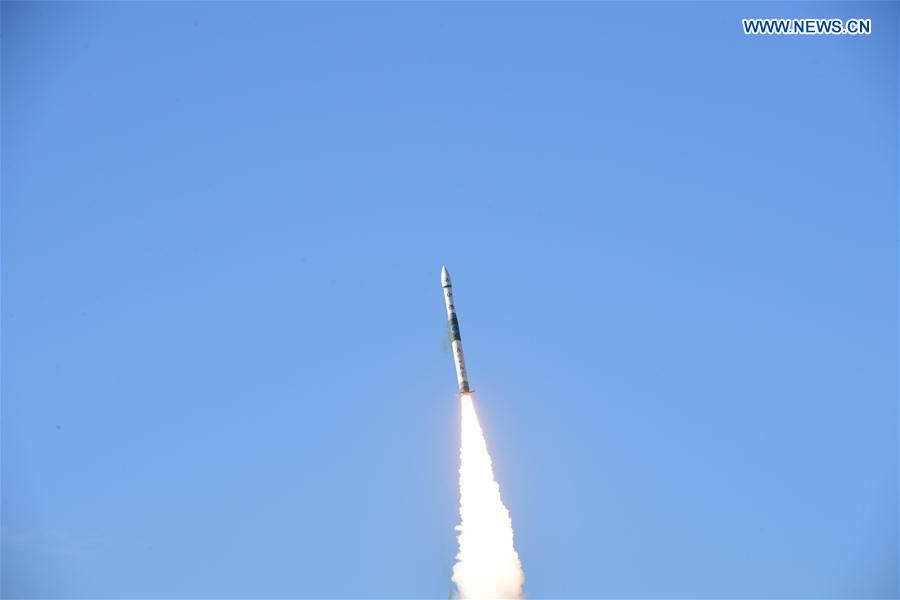Chińska ofensywa trwa 13.11. o 03:40 z z Jiuquan wystrzelona została RN KZ-1A, która wyniosła na orbitę o parametrach: hp=531 km, ha=547 km.
i=97,54º satelitę teledetekcyjnego Jilin-1 Gaofen-02A.
http://lk.astronautilus.pl/n191101.htm#08China launches new remote-sensing satelliteSource: Xinhua| 2019-11-13 15:30:51|Editor: ZX
 Remote sensing satellite Jilin-1 Gaofen 02A is launched with Kuaizhou-1A (KZ-1A) carrier rocket from the Jiuquan Satellite Launch Center in Jiuquan, northwest China's Gansu Province, Nov. 13, 2019. (Photo by Wang Jiangbo/Xinhua)
Remote sensing satellite Jilin-1 Gaofen 02A is launched with Kuaizhou-1A (KZ-1A) carrier rocket from the Jiuquan Satellite Launch Center in Jiuquan, northwest China's Gansu Province, Nov. 13, 2019. (Photo by Wang Jiangbo/Xinhua)JIUQUAN, Nov. 13 (Xinhua) -- China sent a new remote sensing satellite into planned orbit from the Jiuquan Satellite Launch Center in northwest China on Wednesday.
The Jilin-1 Gaofen 02A, which belongs to the Jilin-1 satellite family, was launched by Kuaizhou-1A (KZ-1A), a carrier rocket at 11:40 a.m. (Beijing Time).
KZ-1A is a low-cost solid-fuel carrier rocket with high reliability and a short preparation period. The rocket, developed by a company under the China Aerospace Science and Industry Corporation, is mainly used to launch low-orbit microsatellites.
Wednesday's launch was the second mission of the KZ-1A rocket in 2019. It had previously completed three commercial launches from January 2017 to August 2019.
The Jilin-1 Gaofen 02A satellite is a new optical remote sensing satellite independently developed by Chang Guang Satellite Technology Co., Ltd., featuring high resolution, wide width and high-speed data transmission.
It will form a network with 13 previously launched Jilin-1 satellites, providing remote sensing data and services in fields like agriculture, forestry, resource and environment.
http://www.xinhuanet.com/english/2019-11/13/c_138551735.htmTwo Chinese satellite launchers lift off three hours apartNovember 13, 2019 Stephen Clark
 A solid-fueled Kuaizhou 1A rocket launched from the Jiuquan space base in northwestern China’s Inner Mongolia region at 0340 GMT Wednesday (10:40 p.m. EST Tuesday). Credit: Xinhua
A solid-fueled Kuaizhou 1A rocket launched from the Jiuquan space base in northwestern China’s Inner Mongolia region at 0340 GMT Wednesday (10:40 p.m. EST Tuesday). Credit: XinhuaChinese rockets performed two satellite delivery missions in a three-hour span Wednesday, carrying a commercial Earth-imaging satellite and five mysterious surveillance payloads into orbit.
The launches originated from two separate spaceports in northern China, using a light-class solid-fueled Kuaizhou 1A launcher and a liquid-fueled Long March 6 rocket, according to Chinese state media reports.
The back-to-back launches carried different missions into orbit, and were not originally planned to occur on the same day. Officials aborted a Kuaizhou 1A launch attempt last month for unspecified technical reasons.
The four-stage Kuaizhou 1A rocket — the fourth of its type — blasted off from the Jiuquan space base in northwestern China at 0340 GMT Wednesday (10:40 p.m. EST Tuesday), Chinese state media said.
Liftoff occurred at 11:40 a.m. Beijing time.
The government-run Xinhua news agency reported the Kuaizhou 1A rocket carried a commercial Earth observation satellite for Chang Guang Satellite Technology Co. Ltd., a commercial spinoff of the Chinese Academy of Sciences. The Jilin 1 Gaofen 02A spacecraft is the 14th satellite to join Chang Guang’s Jilin 1 remote sensing constellation since 2015.
Chang Guang’s observation platforms are designed to collect high-definition video, color pictures, and detailed hyperspectral imagery of Earth, providing information to the Chinese military, civilian agencies and commercial users.
The Kuaizhou 1A rocket is managed by Expace, a commercially-oriented subsidiary of the China Aerospace Science and Industry Corp., the biggest Chinese state-backed aerospace contractor. Technical details of the Kuaizhou 1A launcher, capable of injecting 440 pounds (200 kilograms) of payload to a 435-mile-high (700-kilometer) orbit, have not been released by Chinese authorities, but the rocket is likely based on modified Chinese ballistic missile technology.
U.S. military tracking data indicated the Kuaizhou 1A rocket released the Jilin 1 Gaofen 02A spacecraft in an polar orbit approximately 330 miles (535 kilometers) above Earth, with an inclination of 97.5 degrees to the equator.
https://spaceflightnow.com/2019/11/13/two-chinese-satellite-launchers-lift-off-three-hours-apart/China carries out 2 orbital launches inside 3 hoursby Andrew Jones — November 13, 2019
HELSINKI — China launched six remote sensing satellites into orbit with two launches inside three hours from sites in north China.
A commercial Kuaizhou-1A solid rocket lifted off from a transporter erector launcher at the Jiuquan Satellite Launch Center, northwest China, at 10:40 p.m. Eastern Tuesday.
The payload was the Jilin-1 Gaofen-2A optical Earth observation satellite for Changguang Satellite Technology Co. Ltd., a commercial offshoot of the state-owned Changchun Institute of Optics, Fine Mechanics and Physics under the Chinese Academy of Sciences.
The 230-kilogram satellite has a full color resolution of better than 0.75m, multi-spectral resolution better than 3m, and swarth width greater than 40km, according to CGST.
China developing its Earth observation capabilities both on the national level and on the provincial level, says Alexandre Najjar, a space industry analyst at Euroconsult.
“In addition to the Jilin constellation, which is partly financed by the Jilin Provincial Government, the Hainan EO smallsat constellation is sponsored by the Hainan Provincial Government,” notes Najjar, adding that Henan Province has agreed to a deal with Tencent-funded Satellogic which enables Chinese data science company ABDAS to task its satellites on a “constellation as a service” business model.
“In all three cases, the Provincial Government is expected to use the collected data both for its own use, but also for commercial purposes, in order to develop the local economy,” says Najjar.
The launch vehicle belongs to Expace, a commercial subsidiary of the China Aerospace Science and Industry Corporation (CASIC), a giant defense contractor and missile maker.
The Kuaizhou-1A, understood to be derived from missile technology, consists of three solid stages and a liquid propellant upper stage, and is capable of lofting a 200-kilogram payload into a 700-kilometer sun-synchronous orbit (SSO).
The Kuaizhou-1A has now carried out four commercial launches, following a mission late august. A larger Kuaizhou-11 solid launcher has been slated for a test flight since 2018 is yet to fly.
https://spacenews.com/china-carries-out-2-orbital-launches-inside-3-hours/https://www.nasaspaceflight.com/2019/11/kuaizhou-1a-launches-jilin-1-gaofen-2a/https://space.skyrocket.de/doc_sdat/jilin-1-highresolution-03a.htm